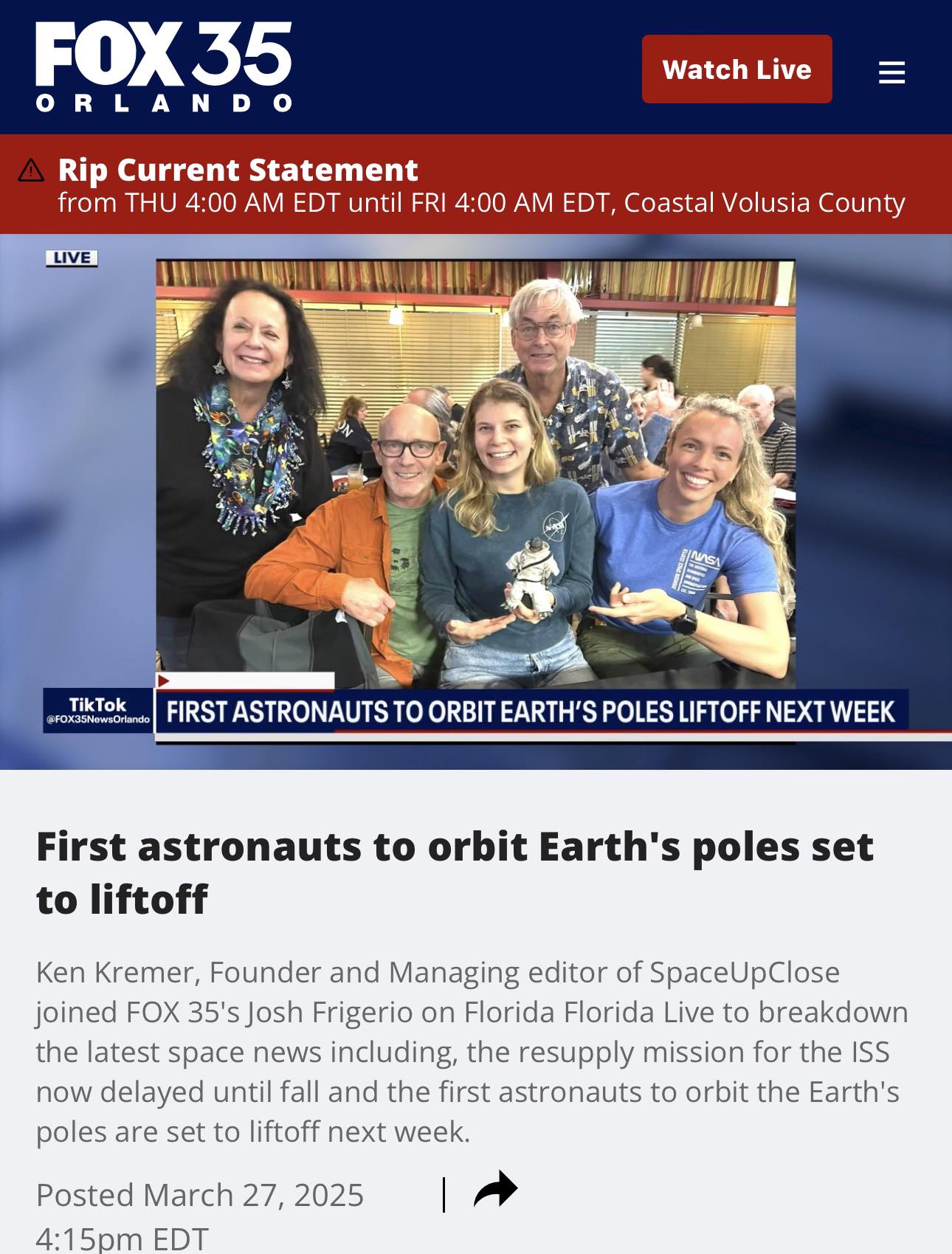
For SpaceUpClose.com & RocketSTEM
CAPE CANAVERAL, FL – Precisely 50 years to the day when humans last landed on the Moon on Apollo 17, NASA’s next generation human rated lunar capsule Orion safely returned to Earth, Sunday, Dec. 11, capping a history making month long demonstration mission around the Moon and back with a successful ocean splashdown off the coast of California after surviving tremendous speeds and scorching temperatures plunging into our Home Planet’s atmosphere.
NASA’s uncrewed Orion spacecraft splashed down in the Pacific Ocean, west of Baja California, at 12:40 a.m. EST (1740 GMT) Sunday, Dec. 11 after a record-breaking mission, traveling more than 1.4 million miles on a path around the Moon and returning safely to Earth, completing a nearly flawless shakedown cruise on the Artemis 1 flight test that now paves the path to returning humans to deep space soon.
“This is what mission success looks like, folks,” said Mike Sarafin, NASA’s Artemis 1 mission manager, at the post splashdown media briefing. “This was a challenging mission.”
Artemis 1 was nearly flawless in every respect and exceeded expectations- accomplishing all 124 primary test objectives as well as some 20 additional bonus objectives added in flight since everything proceeded so well.

Having passed through the harrowing fiery reentry at 25,000 mph and some 5,000 degrees Fahrenheit (a temperature half as hot as the surface of the sun), the NASA capsule finally descended on three main parachutes (116 ft wide) to a splashdown in the Pacific at about 20 mph (32 kph).
Thus accomplishing the primary goal of Orion Artemis 1 – proving that the heat shield would function as designed and protect astronauts seated inside on their return to Earth from deep space at human reentry speeds not tested since NASA’s Apollo moon landing era concluded half a century ago.
SUCCESS!! @NASA_Orion deploys 11total & 3main chutes as planned. Splashdown 1240 PM ET off Baja Calif coast!! Stable & upright w all 5 bags deployed!! concludes 25.5 day,1.4 mil mi #Artemis1 test flight achieving all objectives!! Paves path to crew on #Artemis2 lunar flyby 2024 https://t.co/x2DAwAeqAL
— Ken Kremer🇺🇦🇩🇪🇺🇸🚀🧪 (@ken_kremer) December 11, 2022
The entire 25.5-day Artemis 1 adventure from start to finish to the Moon and back was carried out publicly with everything on the line to bring folks along for a birds eye view – and broadcast live on NASA TV
“The splashdown of the Orion spacecraft – which occurred 50 years to the day of the Apollo 17 Moon landing – is the crowning achievement of Artemis I. From the launch of the world’s most powerful rocket to the exceptional journey around the Moon and back to Earth, this flight test is a major step forward in the Artemis Generation of lunar exploration,” said NASA Administrator Bill Nelson.
“It wouldn’t be possible without the incredible NASA team. For years, thousands of individuals have poured themselves into this mission, which is inspiring the world to work together to reach untouched cosmic shores. Today is a huge win for NASA, the United States, our international partners, and all of humanity.”
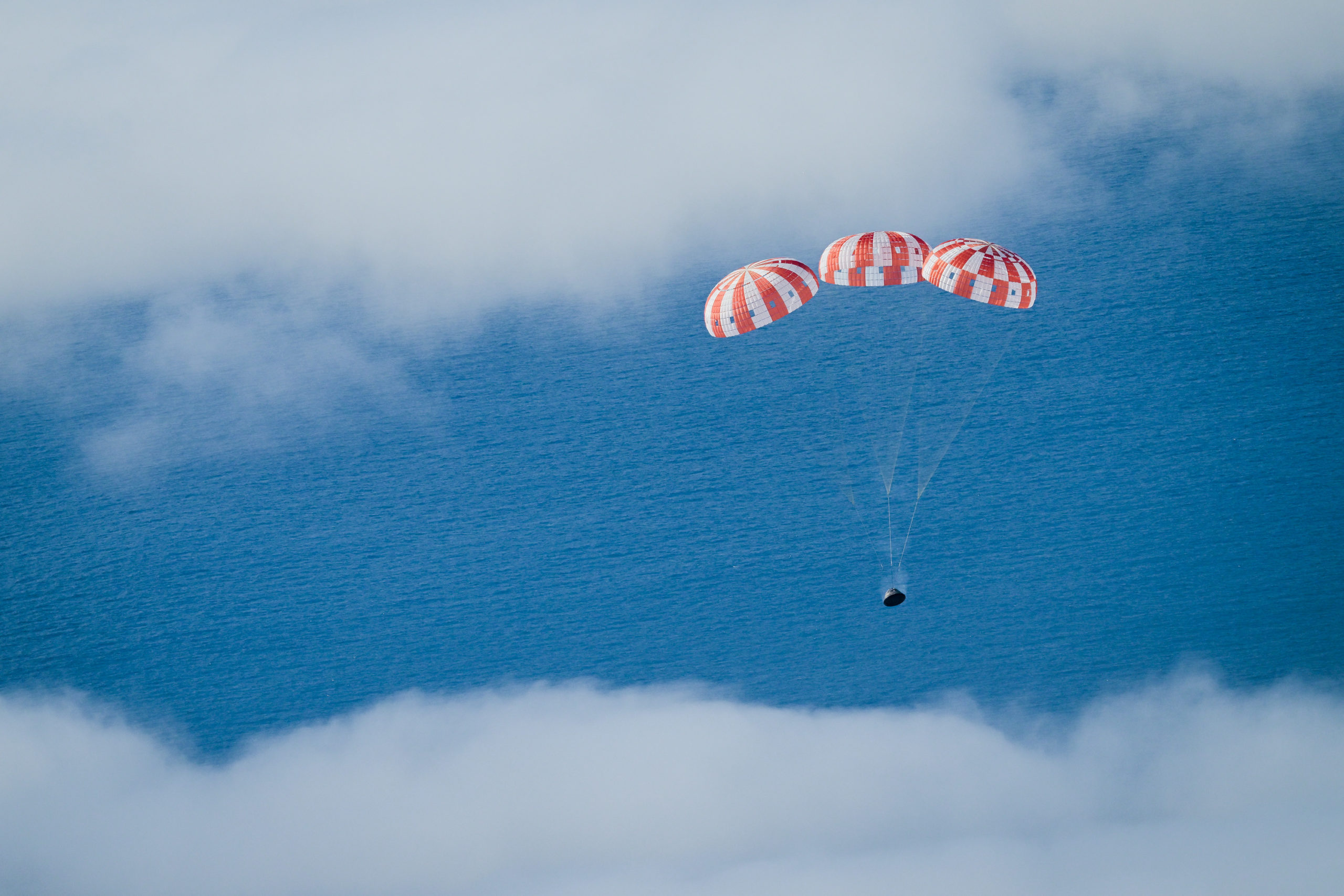
As it barreled homewards cameras attached on Orion’s solar array wings captured spectacular views of the blue planet Earth – growing ever larger in apparent size with oceans and continents in view.

Flight Day 26. Orion is returning to Earth. 20,000 miles / 32,000 km from Earth. Traveling at 9,600 mph / 15,500 kmh and accelerating. pic.twitter.com/EWCKXkChjg
— Orion Spacecraft (@NASA_Orion) December 11, 2022
Some 40 minutes prior to entering the Earth’s atmosphere, NASA’s Orion crew module (built by prime contractor Lockheed Martin) separated from its service module, which is the propulsive powerhouse provided by ESA (European Space Agency).
Within about 20 minutes from entry interface, Orion slowed from nearly 25,000 mph to about 20 mph for its parachute-assisted splashdown.
The 16.5 ft (5 m) diameter Orion capsule was so precisely controlled that it landed only 2.1 nautical miles from its targeted ocean landing site. NASA was aiming to land within 5 nautical mile of the target – to enable quick recovery of the capsule this time and astronauts on future flights.
Simultaneously it whets our appetites with spectacular astronauts eye views of whats in store the next time Orion flies with a crew of four on the Artemis 2 mission slated for liftoff by late 2024.
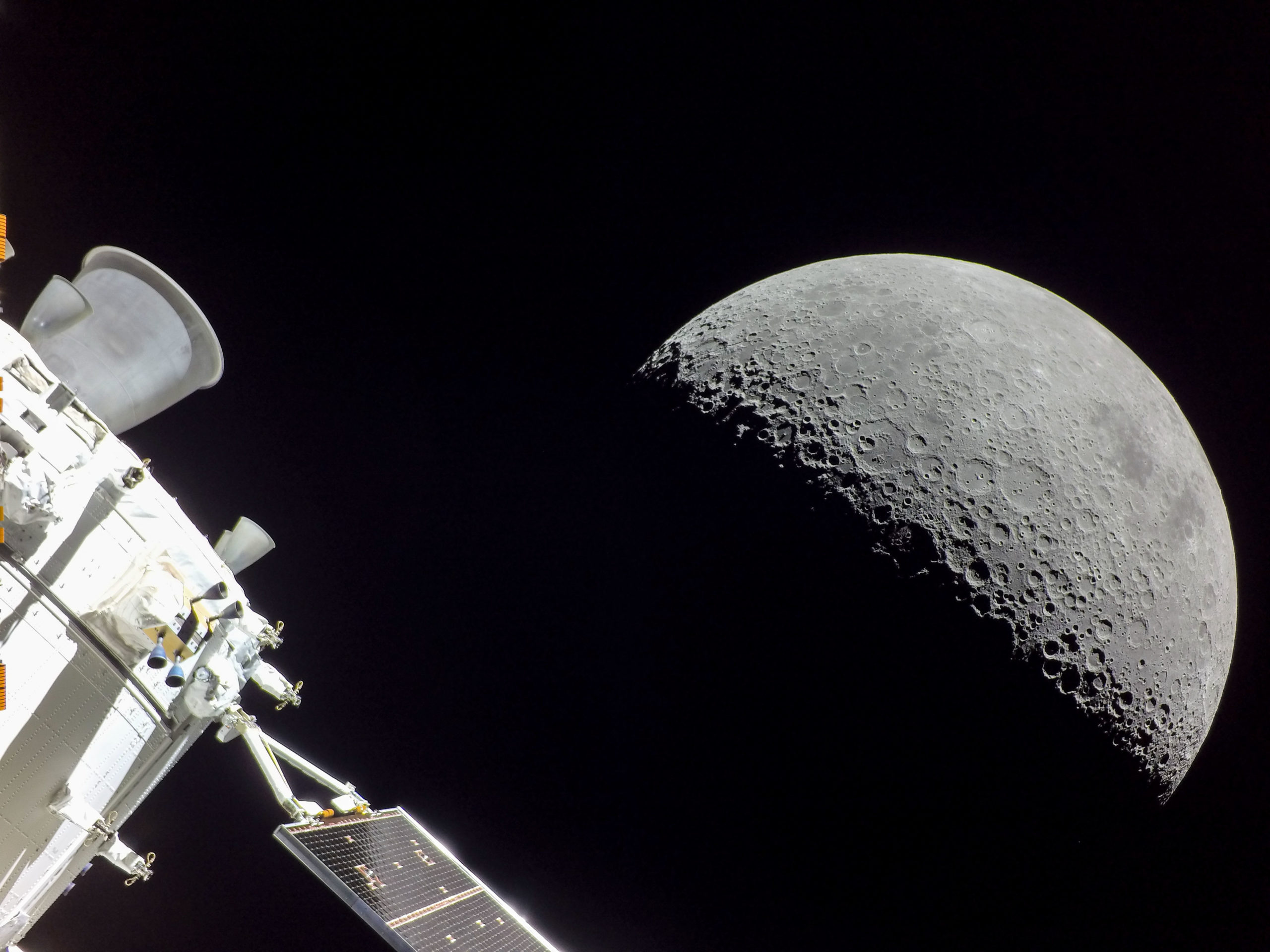
Check out this HD gallery of additional splashdown and recovery images from NASA:
Did you miss @NASA_Orion splash down yesterday after its 1.4-million-mile (2.3-million-km) journey around the Moon and back again?
Check out our HD gallery of #Artemis I photos: https://t.co/6lze8gnUPZ pic.twitter.com/25euJZvy19
— NASA (@NASA) December 12, 2022
To set up the Sunday’s splashdown, Orion harnessed the Moon’s gravity significantly bending its trajectory for a slingshot maneuver back to Earth at a distance of a quarter of a million miles on Flight Day 20 of the 26-day unpiloted Artemis 1 mission.
The spacecraft made its second and final close approach to the Moon at 11:43 a.m. EST Monday, Dec. 5, just before its return powered flyby burn, passing 80.6 miles (129 km) above the lunar surface.
“With Orion safely returned to Earth we can begin to see our next mission on the horizon which will fly crew to the Moon for the first time as a part of the next era of exploration,” said Jim Free, NASA associate administrator for the Exploration Systems Development Mission Directorate.
“This begins our path to a regular cadence of missions and a sustained human presence at the Moon for scientific discovery and to prepare for human missions to Mars.”
— Jim Free (@JimFree) December 12, 2022
Orion used a skip reentry technique with two precisely planned dips into the atmosphere to slow and bleed of its high speed, reduce-g-loads for passengers aboard, and lower the heat loads on the capsules external thermal protection system skin as it smashes into the Earth atmosphere at some 25,000 mph 33,300 kph) and reaches about 5000 degrees Fahrenheit (2760 C).

The skip re-entry trajectory also allowed the Orion team to more precisely target the capsule to its splashdown zone nearer to the recovery forces.
Frictional drag and eventually 11 parachutes slowed Orion down to a splashdown speed of a much gentler 20 mph.
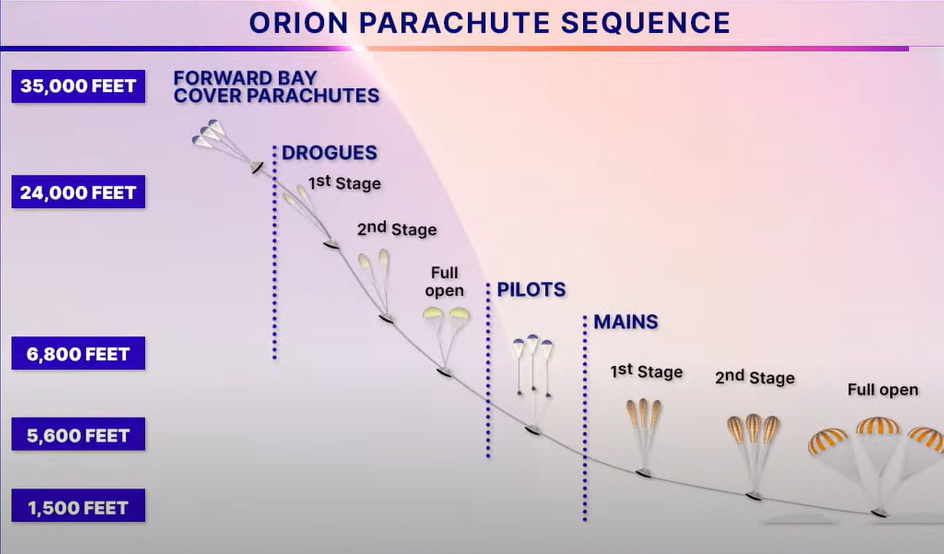
NASA and U.S. Navy recovery forces and dive teams in the sea and by helicopter quickly approached Orion post splashdown in fast boats, safed it and placed it on a cradle to transport into the well deck of the U.S.S. Portland
All 5 uprighting bags deployed as planned after splashdown to orient Orion into the upright ‘Stable 1’position.
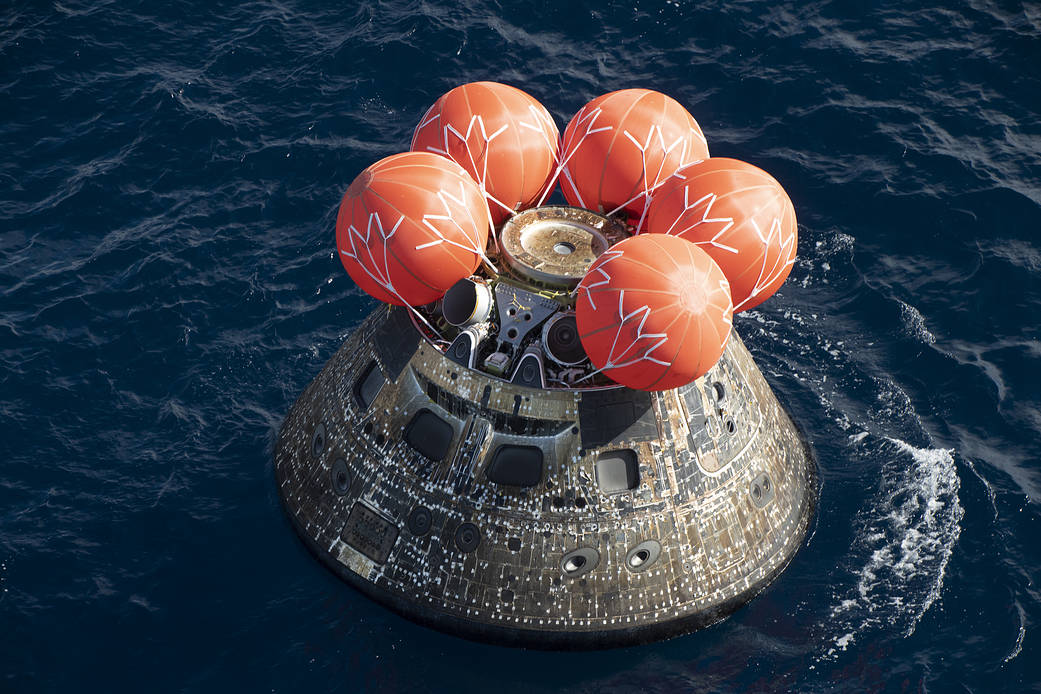
During the mission, Orion performed two lunar flybys, coming within 80 miles of the lunar surface. At its farthest distance during the mission, Orion traveled nearly 270,000 miles from our home planet, more than 1,000 times farther than where the International Space Station orbits Earth, to intentionally stress systems before flying crew.

During the flight test, Orion stayed in space longer than any spacecraft designed for astronauts has done without docking to a space station. While in a distant lunar orbit, Orion surpassed the record for distance traveled by a spacecraft designed to carry humans, previously set during Apollo 13.
“Orion has returned from the Moon and is safely back on planet Earth,” said Mike Sarafin, Artemis I mission manager. “With splashdown we have successfully operated Orion in the deep space environment, where it exceeded our expectations, and demonstrated that Orion can withstand the extreme conditions of returning through Earth’s atmosphere from lunar velocities.”
Recovery teams are now working to secure Orion for the journey home. NASA leads the interagency landing and recovery team on the USS Portland, which consists of personnel and assets from the U.S. Department of Defense, including Navy amphibious specialists, Space Force weather specialists, and Air Force specialists, as well as engineers and technicians from NASA Kennedy, the agency’s Johnson Space Center in Houston, and Lockheed Martin Space Operations.
In the coming days, Orion will return to shore where technicians will offload the spacecraft and transfer it by truck back to Kennedy. Once at Kennedy, teams will open the hatch and unload several payloads, including Commander Moonikin Campos, the space biology experiments, Snoopy, and the official flight kit. Next, the capsule and its heat shield will undergo testing and analysis over the course of several months.
Overall Orion journeyed 1.4 million miles from the Nov. 16 launch to Dec. 11 splashdown

Orion has unveiled the Earth-Moon system as never before.
All 8 Billion humans are here together as one folk!
One step closer to home 🌎
On Dec. 5 at 11:42 am EST, @NASA_Orion completed its return powered flyby of the Moon, making its way back to Earth. At its closest approach, the spacecraft was only about 80 miles away from the lunar surface. #Artemis pic.twitter.com/0bWmyRGjlI
— NASA's Johnson Space Center (@NASA_Johnson) December 6, 2022
NASA’s Orion Artemis 1 spacecraft snapped a series of staggeringly beautiful selfie views with the cratered lunar surface and the rising crescent Earth against an eerie backdrop of the blackness of space as it conducted the critical return flyby powered (RPF) maneuver Monday, Dec. 5 – that irreversibly committed the capsule to departing lunar orbit and a return to the Home Planet after completing a final close flyby of the Moon and finishing the final major burn of the unprecedented test flight.

Among many firsts, Orion Artemis 1 also surpassed the previous human spaceflight distance record of 248,654 miles (397,864 km) set by the Apollo 13 crew all the way back in 1970, and finally exceeded on Saturday, Nov. 26.
Two days later on Monday, Nov. 28, Orion reached its greatest distance from Earth at over 268,500 miles (432,000 kilometers).
Orion also captured stunning up close imagery of the tortured lunar surface terrain during the unpiloted vehicles 1st close flyby orbiting around the Moon’s far side on Flight Day 6 of the test flight mission on 21 Nov. 2022.
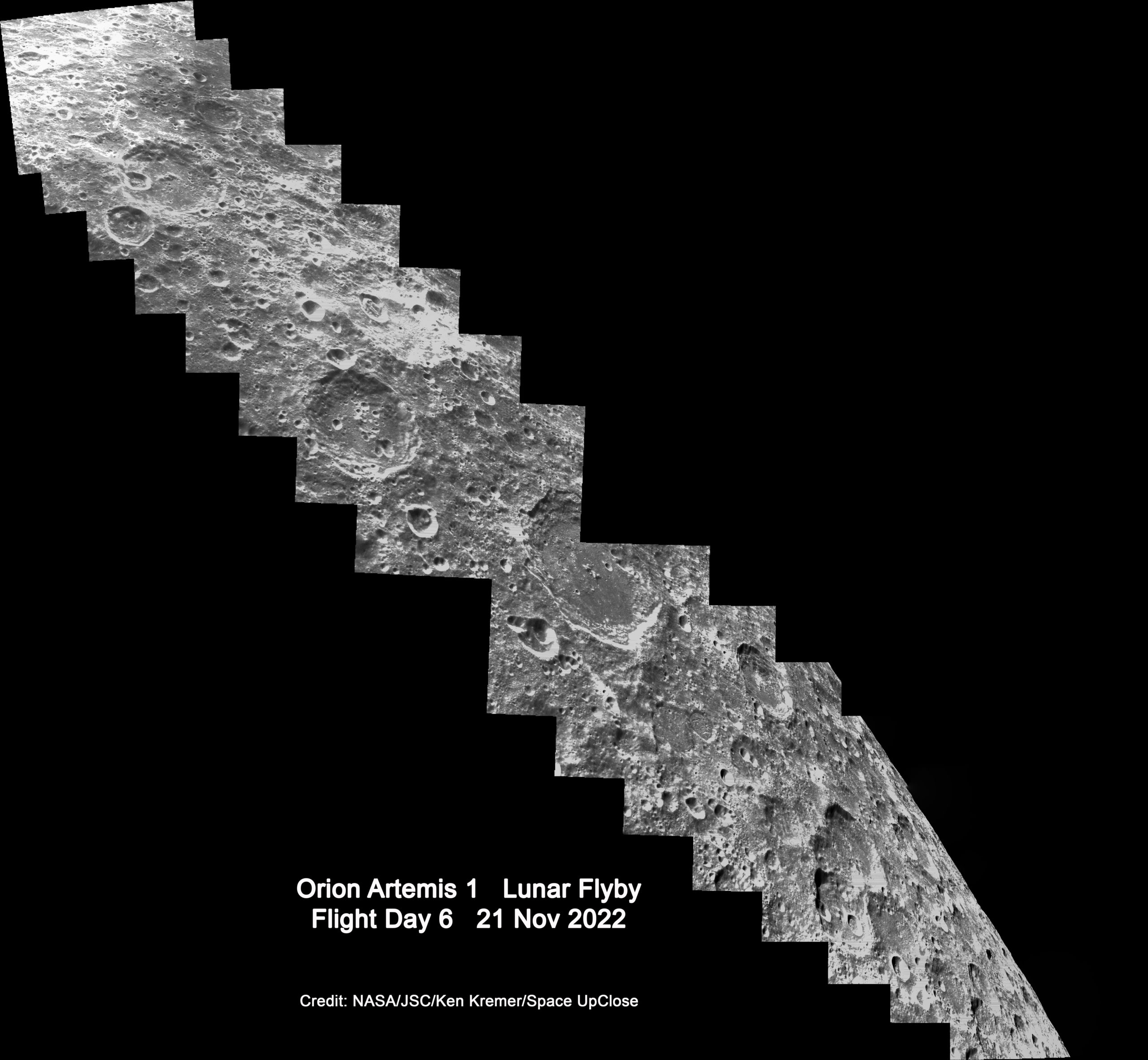
I’ve created a trio of up close lunar mosaics from the detailed images taken by Orion by stitching together NASA black and white raw images taken by the optical navigation camera – showing the heavily cratered surface and illustrating this story.
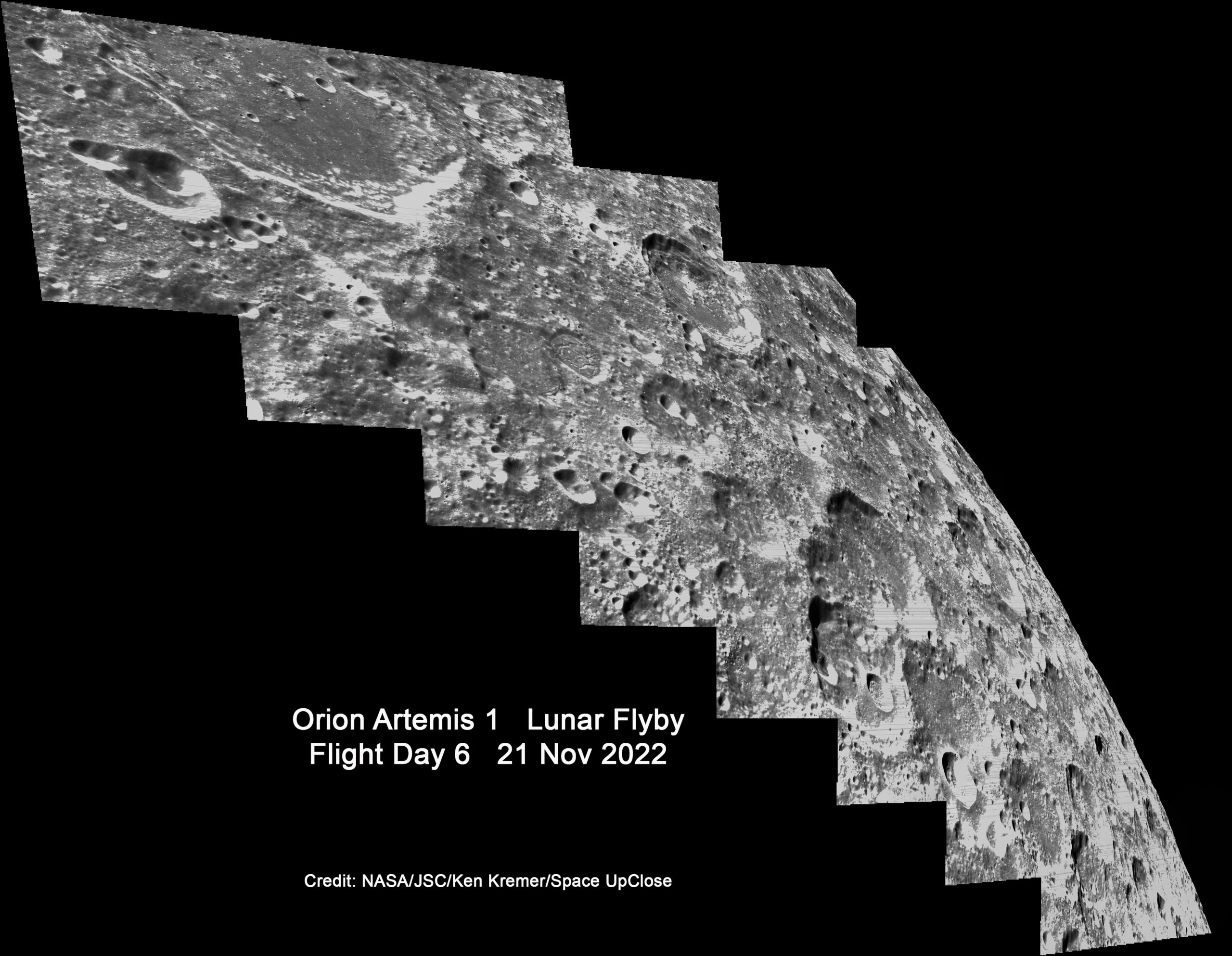
The long mosaic shows the entire ground track of the pockmarked surface of our nearest celestial neighbor as seen in 17 raw images snapped by Orion soaring over the Moon during its closest approach Nov. 21.

The other two mosaics show the detailed upper and lower halves individually, across out to the Moon’s limb and the blackness of space.
Artemis 1 is paving the way for America’s return to the Moon with astronauts on the next flight on Artemis 2 set for launch in 2024 and eventually the next lunar landing on Artemis 3 around mid-decade and no earlier than late 2025.
On Artemis 3 NASA will land the first woman and the first person of color on the surface of the Moon, paving the way for a long-term lunar presence and serving as a steppingstone for astronauts on the way to Mars.
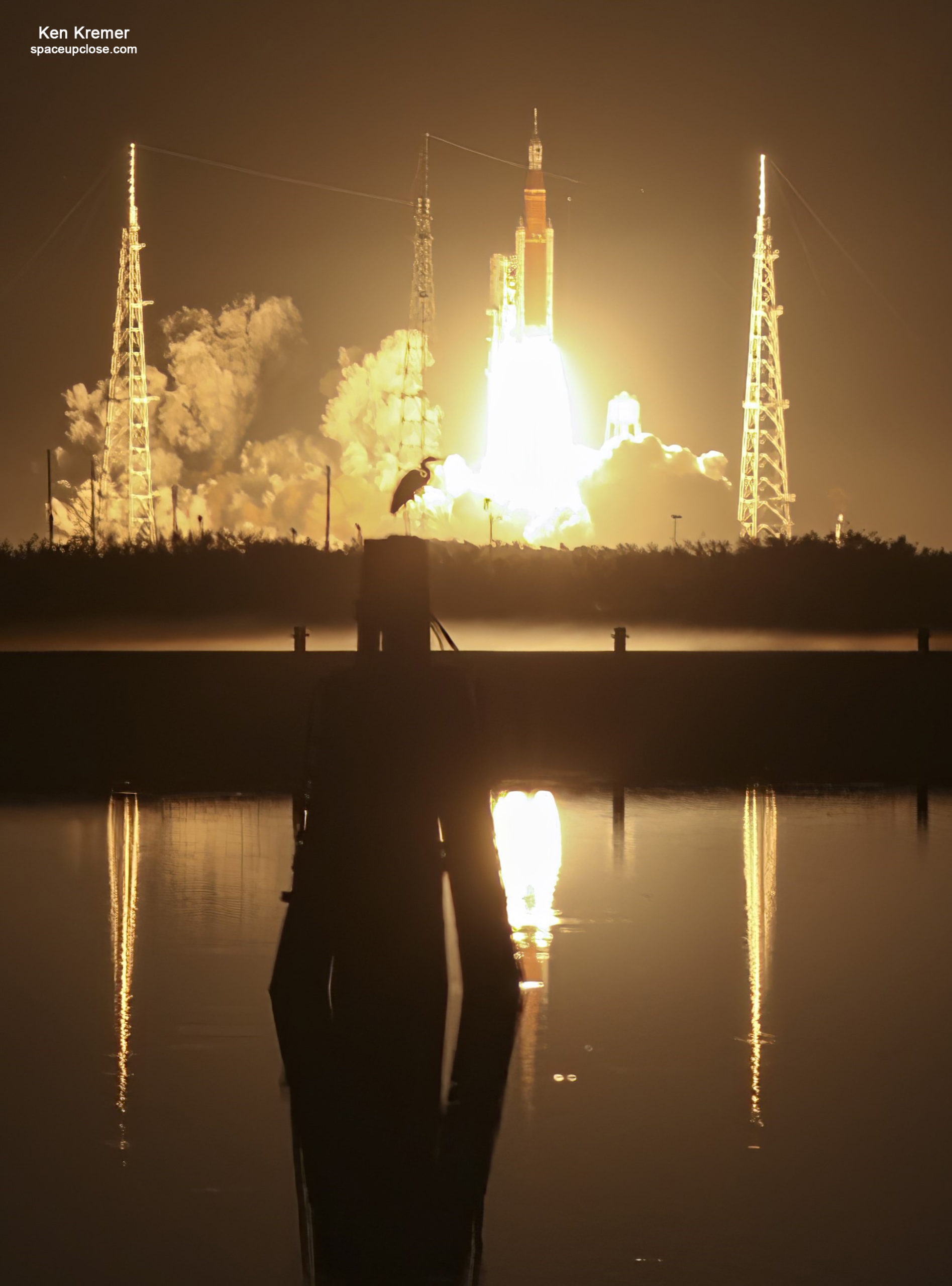
The test flight of the uncrewed Orion capsule began with the stunning debut liftoff of NASA Space Launch System (SLS) mega moon rocket on the Artemis 1 mission at 1:47 a.m. EST (0647 GMT) Wednesday, Nov. 16 from Launch Pad 39B at the Kennedy Space Center in Florida – sending America to the moon with the 1st human rated capsule in 50 years.

SLS now counts as the world’s the most powerful rocket ever built – about 15 to 20% more powerful than NASA’s Apollo Saturn V moon rocket and the Space Shuttle.
The primary objectives for the Artemis 1 mission that must be accomplished following the successful launch and delivery by the SLS moon rocket are: demonstrating Orion’s heat shield at lunar return re-entry conditions, demonstrating operations and facilities during all mission phases, and retrieving the spacecraft after splashdown.

Artemis 1 is the first integrated flight test of the agency’s deep space exploration systems: the Orion spacecraft, Space Launch System (SLS) rocket, and ground systems and the mission is a critical part of NASA’s Moon to Mars exploration strategy.
The 32-story tall Artemis 1 stack is comprised of NASA’s Space Launch System (SLS) Mega moon rocket integrated with the Orion crew spacecraft on top.
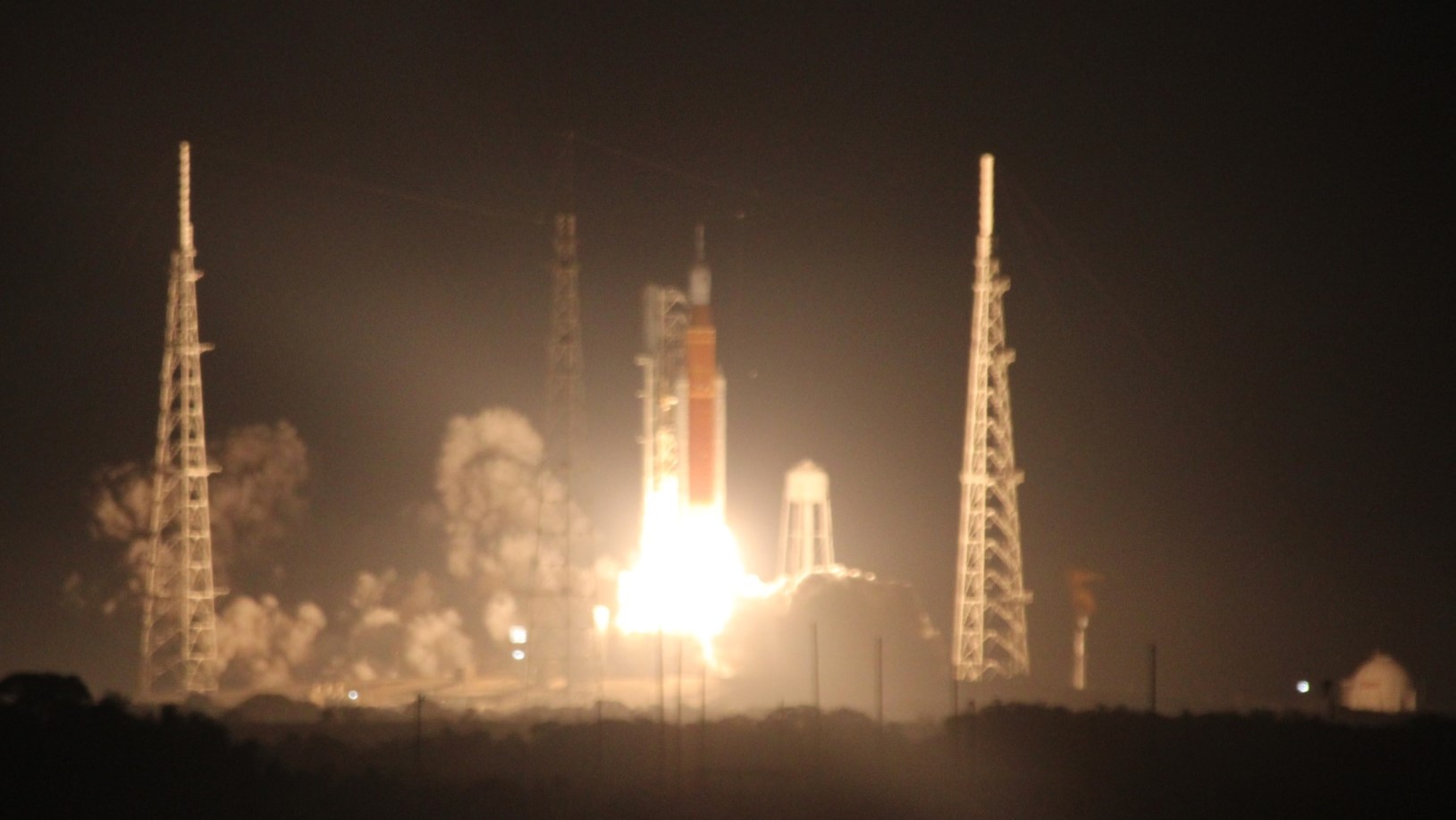
Overall the Artemis 1 mission with SLS and Orion performed flawlessly – with no significant technical issues arising.

NASA is used the DRO orbit for Artemis 1 because it is a very fuel efficient trajectory around the moon requiring minimal thruster firings.
The DRO orbital trajectory purpose is to test Orion to its limits for nearly a month and will not be used on any future Artemis missions.
DRO is “distant” in “the sense that it’s at a high altitude approximately 50,000 miles from the surface of the Moon. Due to the distance, the orbit is so large that it will take the spacecraft six days to complete half of a revolution around the Moon before exiting the orbit for the return journey back to Earth.”
Future Artemis moon landing mission and NASA’s planned Gateway lunar orbiting mini space station will use the NRHO orbit – or near rectilinear halo orbit to provide access to the lunar south pole and caches of lunar water ice inside permanently shadowed craters.

Watch Ken’s commentary about Project Artemis, SpaceX Falcon Heavy, Crew-5, NASA SLS cryo and WDR tests, NASA SpaceX Crew & Cargo Dragons and more
Dec 11/12: BBC World News TV interview about successful splashdown of NASA Orion concluding the 25 day Artemis 1 lunar test flight around the Moon and back, and how that sets up a human return to the Moon on Artemis 2 and landing on Artemis 3. Plus what’s beyond for NASA deep space exploration to Mars and the search for life beyond Earth

Nov 22: WFTV ABC News Orlando interview about upcoming NASA SpaceX CRS 26 cargo resupply mission to the ISS and science aboard + Artemis 1 launch and Orion crew capsule successfully entering lunar orbit, results and mission goals
Nov 22: Fox 35 interview about upcoming NASA SpaceX CRS 26 cargo resupply mission to the ISS and science aboard + Artemis 1 launch and Orion crew capsule successfully entering lunar orbit, results and mission goals
Nov 21/22: BBC World TV interview about Orion crew capsule successfully entering lunar orbit, results and mission goals
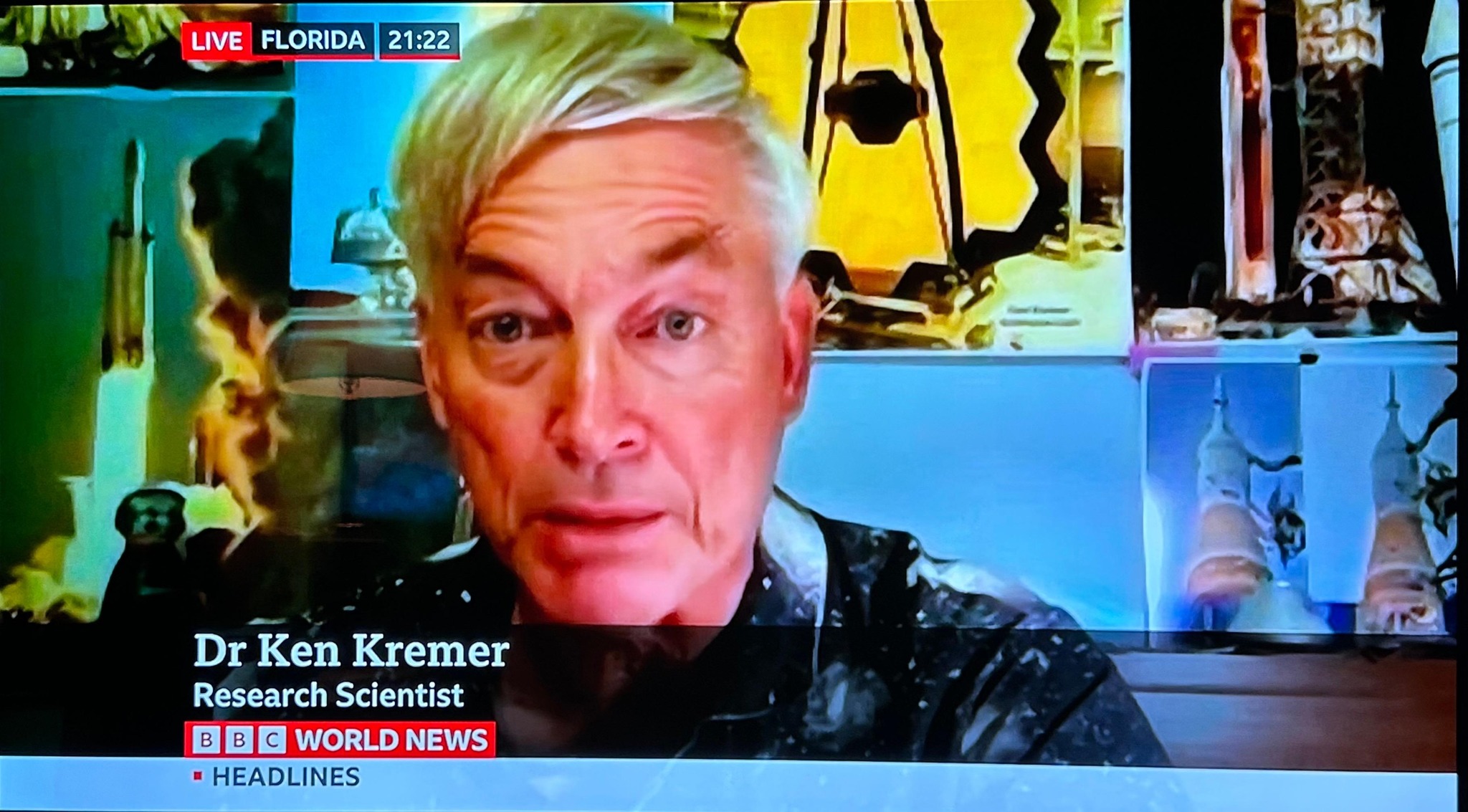
Nov 16: Fox 35 Orlando live and taped interviews about Artemis 1 launch and goals

Nov 15/16: News Nation interview about Artemis 1 launch and goals
Nov 7/8: Fox 35 Orlando – As subtropical storm Nicole approaches KSC and Florida watch my comments about NASA deciding for the moment to keep Artemis 1 moon rocket at pad 39b and not roll back to VAB
https://www.fox35orlando.com/news/nasa-says-its-keeping-artemis-outside-during-major-storm
NASA says it's keeping Artemis on the launch pad. The rocket can withstand winds up to 85 miles an hour. The @NWSMelbourne is predicting windspeeds could very well hit that point in Brevard County – in fact, a Tuesday morning update says windspeeds could be in the 74-110mph range pic.twitter.com/i569eAmi9p
— Marie Edinger FOX 35 (@MarieEdinger) November 8, 2022
Nov 4/5: WFTV ABC News Orlando featured my commentary about Artemis 1 rollout overnight and goals of NASA lunar test flight mission launching Nov 14 at 1207 AM
Nov 4: Fox 35 Orlando featured my commentary about Artemis 1 rollout overnight and goals of NASA lunar test flight mission launching Nov 14

Nov 1: Fox 35 Good Day Orlando morning show featured my live and taped prelaunch interview commentary about SpaceX Falcon Heavy launch with Space Force national security payloads
Nov 1: WFTV ABC News featured my commentary about SpaceX Falcon Heavy launch with Space Force national security payloads
https://news.yahoo.com/watch-lve-spacex-launches-falcon-100341265.html
Oct 31: WFTV ABC News featured my commentary about SpaceX Falcon Heavy launch with Space Force national security payloads
Oct 27: WFTV ABC News and Fox 35 Orlando featured my commentary about Falcon Heavy and the Space Force national security payloads
https://www.fox35orlando.com/video/1137117
Watch Ken’s continuing reports about Artemis, SpaceX missions, SLS, Orion and NASA missions, SpaceX Crew and Cargo Dragons, SpaceX Axiom, JWST, DART, Lucy Asteroid mission, GOES, SpaceX Starlink, Commercial Crew and Starliner and Crew Dragon, Blue Origin and Space Tourism, and onsite for live reporting of upcoming and recent SpaceX and ULA launches including Crew 1 & 2 & 3 & 4 & 5, ISS, Solar Orbiter, Mars 2020 Perseverance and Curiosity rovers, NRO spysats and national security missions and more at the Kennedy Space Center and Cape Canaveral Space Force Station.
Stay tuned here for Ken’s continuing Earth and Planetary science and human spaceflight news: www.spaceupclose.com – twitter @ken_kremer – email: ken at kenkremer.com
Dr. Kremer is a research scientist and journalist based in the KSC area, active in outreach and interviewed regularly on TV and radio about space topics.
………….
Ken’s photos are for sale and he is available for lectures and outreach events
Please consider supporting Ken’s work by purchasing his photos and/or donating at Patreon
https://www.patreon.com/kenkremer
Upcoming and recent space events and talks by Ken Kremer & Jean Wright
Nov 29 at UCF, Orlando Florida: Presentation by Jean Wright – “Sew Sister to the Stars- How the Humble Art of Sewing Transformed the World of Flight”
Upcoming and recent space events and talks by Ken Kremer & Jean Wright
Dec 7/10/15 and Nov 25/29 from 7 to 9 PM Quality Inn, Titusville, FL: Join Ken and Jean for Artemis 1, Falcon Heavy and space mission and rocket launch outreach. Ask us anything. plus display our photos and space apparel items for sale



X
x


